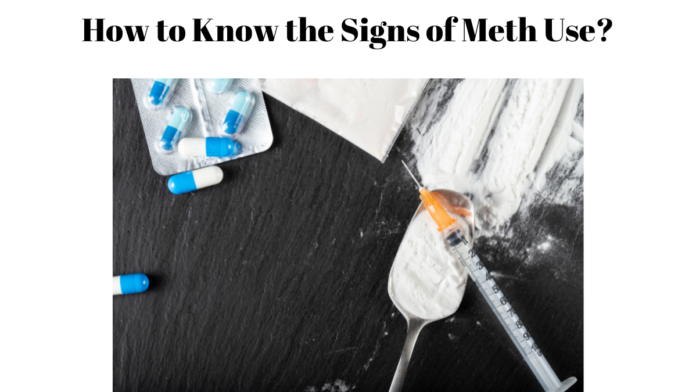Signs of meth use – Meth addiction is well known for its devastating outcomes. The patterns and signs of meth use are quickly noticeable and detectable.
Signs of Meth Use
Meth (methamphetamine) is a highly dangerous but widespread illegal stimulant with effects ranging from physiological to mental. The identification of the indicators when a person is using Meth can help with timely intervention and adequate support. Meth abuse symptoms may be physical or mental in nature.
Physical Signs of Meth Use
Physical signs that someone is using Meth can include:
- Dilated pupils: Using Meth usually makes the pupils to be extremely large which make them look much bigger than usual. This is the first noticeable symptom of meth consumption.
- Skin sores: Individuals who use Meth may develop meth sores or skin ulcers caused by frequent intense itching, which leads to persistent scratching. These wounds heal and scar.
- Facial twitching: Facial twitching or repetitive movements may result from Methamphetamine use.
- Increased sweating: Meth use has a high tendency to lead to excessive sweating and feelings of heat in the body.
- High body temperature: Among the symptoms of Meth, a dangerously high body temperature can be noted that may result in hyperthermia.
Mental Signs of Meth Use
Mental signs someone is on Meth may include:
- Agitation and irritability: Mental indicators of a person taking Meth may include agitation, irritability or mood swings.
- Confusion: Symptoms of Meth include confused and disoriented users who are unable to focus or maintain conversations coherently.
- Paranoia: Some people under the influence of Meth become paranoid and delusional, believing that they are being closely watched or persecuted.
- Hallucinations: Meth addicts suffer auditory or visual hallucinations – seeing or hearing things that do not exist.
- Repetitive behaviours: Use of Meth results in several repetitive, compulsive behaviours such as skin picking. This is linked to various skin disorders.
Signs of Meth Addiction
Signs of meth addiction can include:
- By taking more Meth than needed or over a prolonged period.
- Attempting but failing to reduce meth use.
- A lot of time is spent on the use of Meth.
- Strong cravings for methamphetamine.
- The failure to attend to one’s work or personal obligations because of meth use.
- The continued use of Meth in the presence of problems with friends or family.
- Losing significant social functions due to stimulant consumption.
- Using Meth in risky situations.
- The continued use following a physical or mental health problem due to Meth.
- As to more Meth for the same response.
- Having withdrawal effects when not taking Meth.
If one person displays two or more of these indicators, he may suffer from stimulant use disorder or meth addiction. It is necessary to contact a healthcare or mental health specialist for an appropriate diagnosis and get the professional help required for treatment and rehabilitation.
What to do if you notice those signs someone may be on Meth?
In case you suspect that a person close to you is using Meth or have noticed signs of meth use, do not hesitate to help them. Here are steps you can consider:
- Educate yourself: First, find out what the symptoms of meth use and addiction are before you go to that person. Knowledge about the drug’s effects can make you face the situation in a more educated way.
- Choose the right time and place: Find an opportunity to talk privately with the person. Ensure you will not be disturbed, and find a time when they look calm and open to communication.
- Express concern and empathy: You need to sympathise with them and let them know that you are worried about their health. Do not criticize or ridicule them because addiction is a complex issue that has deep-rooted emotional disturbance.
- Listen actively: Let the person share his experiences and feelings. Their struggles and the reasons why they use Meth can be discussed through active listening.
- Offer support: Let them know that you stand with them and addiction is a fight they are not alone in. Encourage them to get professional help, which could be addiction treatment, or even solve the issue by receiving counselling.
- Avoid enabling: When offering help, do not enable their addiction. This entails not giving them money or resources through which they can get drugs. Encourage healthy choices instead.
- Seek professional help: If the individual is reluctant to rehabilitation or if his addiction seems a major threat, contacting a professional interventionist or addiction specialist should be suggested. These professionals help to conduct an intervention and link the individual with suitable treatment services.
Consider that addressing someone’s meth use can be difficult and intense.
FAQs
Q: What are the symptoms of meth use?
A: Some of the symptoms are more use than intended, failed withdrawal attempts, a lot of time spent on meth usage and intense cravings.
Q: Does neglecting personal or work responsibilities lead to meth addiction?
A: Yes, this is one way by which meth addiction can be identified.
Q: Is craving for methamphetamine a common sign?
A: Yes, wanting meth badly is definitive that an individual will possibly use methamphetamine.
Q: Is it bad if meth is used when there can be a danger?
A: Of course, meth use in risky settings is a symptom of substance abuse.















